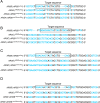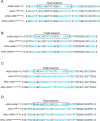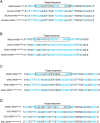Generation of a novel disease model mouse for mucopolysaccharidosis type VI via c. 252T>C human ARSB mutation knock-in
- PMID: 36032399
- PMCID: PMC9399948
- DOI: 10.1016/j.bbrep.2022.101321
Generation of a novel disease model mouse for mucopolysaccharidosis type VI via c. 252T>C human ARSB mutation knock-in
Abstract
Mucopolysaccharidosis type VI (MPS VI) is an autosomal recessive lysosomal disorder caused by a mutation in the ARSB gene, which encodes arylsulfatase B (ARSB), and is characterized by glycosaminoglycan accumulation. Some pathogenic mutations have been identified in or near the substrate-binding pocket of ARSB, whereas many missense mutations present far from the substrate-binding pocket. Each MPS VI patient shows different severity of clinical symptoms. To understand the relationship between mutation patterns and the severity of MPS VI clinical symptoms, mutations located far from the substrate-binding pocket must be investigated using mutation knock-in mice. Here, I generated a knock-in mouse model of human ARSB Y85H mutation identified in Japanese MPS VI patients using a CRISPR-Cas9-mediated approach. The generated mouse model exhibited phenotypes similar to those of MPS VI patients, including facial features, mucopolysaccharide accumulation, and smaller body size, suggesting that this mouse will be a valuable model for understanding MPS VI pathology.
Keywords: Arylsulfatase B; CRISPR-Cas9 system; Disease model; Mucopolysaccharidosis type VI.
© 2022 The Author.
Conflict of interest statement
The authors declare the following financial interests/personal relationships which may be considered as potential competing interests. Kosuke Hosoba reports financial support was provided by 10.13039/501100001691Japan Society for the Promotion of Science.
Figures












References
-
- Golda A., Jurecka A., Opoka-Winiarska V., Tylki-Szymańska A. Mucopolysaccharidosis type VI: a cardiologist's guide to diagnosis and treatment. Int. J. Cardiol. 2013;167:1–10. - PubMed
-
- Harmatz P.R., Shediac R. Mucopolysaccharidosis VI: pathophysiology, diagnosis and treatment. Front. Biosci. Landmark. 2017;22:385–406. - PubMed
-
- Mut M., Cila A., Varlı K., Akalan N. Multilevel myelopathy in Maroteaux–Lamy syndrome and review of the literature. Clin. Neurol. Neurosurg. 2005;107:230–235. - PubMed
LinkOut - more resources
Full Text Sources

